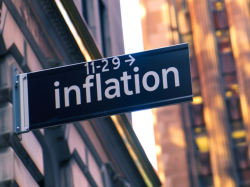If You Made $70,000 Salary When Trump Was Elected, You'd Need $90,000 Today To Keep Up
Author: Natan Ponieman | May 16, 2024 03:39pm
A fresh inflation reading for April had economists on Wednesday hopeful that a soft landing scenario is still possible for the American economy.
With consumer prices 3.4% higher than in April 2023, there's widespread expectation among pundits for the Fed to drop interest rates by at least 0.5% by the end of the year.
The S&P 500 Index, followed by ETFs such as SPDR S&P 500 ETF Trust (NYSE:SPY) and the Vanguard S&P 500 ETF (NYSE:VOO), is pricing in these hopes, climbing up about 1.5% since the markets closed on Tuesday.
How Bad Was Inflation In The Past Decade?
The most recent inflationary cycle peaked in June 2022, when the consumer price index stood 9.1% higher than the previous year.
While the rise in prices has cooled down from its more concerning readings, inflation continues to worry both the public and the Fed, with hopes to reach the ideal rate of 2% before the economy suffers too much from an overall drop in spending.
Back in 2015, the U.S. economy had the inverse problem of today. Inflation was very low, with some months even registering deflation, meaning that consumer prices were lower than the previous year. This scenario can hurt the economy as people and businesses become incentivized to pause spending in the hopes that products and services will become cheaper in the future.
The following years showed a somewhat stable trend, with the average monthly inflation for each year in the period between 2016 and 2020 staying between 1.3% and 2.4%. The current high-inflation cycle started in early 2021, affected by the outbreak of the war in Ukraine as well as previous supply chain disruptions and changes in consumer behavior during the COVID-19 pandemic, according to the Bureau of Labor Statistics.
Read also: US Inflation Data Prematurely Released By Accident, Yet Traders Missed Golden Opportunity
How Much Do I Need To Earn Now To Break Even Vs. 2017?
Since Donald Trump assumed his presidency in January 2017, prices have risen almost 30%. $100 at the time would buy roughly the same things as $129.12 of today.
The median U.S. worker would need to make at least 29.1% more than in January 2017 to break even.
For 2016, the median household income was $70,840. A household in that wage category would need to be earning an annual income of at least $91,468 today to have avoided losing purchasing power.
The median household income in the U.S., as per the most recent data from the 2022 census, is $74,580. This is down from a peak of $78,250 in 2019, just before the pandemic struck.
For someone earning $50,000 a year in January 2017, the equivalent salary today would be $64,560. Similarly, for someone earning $100,000 a year in January 2017, the equivalent salary today would be $129,120.
Based on these numbers, the median American worker has lost purchasing power during the latest inflationary cycle. However, this analysis does not account for any potential raises that may have been given between March 2022 and today.
According to a recent report by the U.S. Treasury, the opposite might be true. While many products and services have increased in price since before the pandemic, like prescription drugs and internet services, others have dropped, like health insurance and airline fares.
Pricing in salary increases for the average American purchasing a "consumption bundle" of different products and services, the Treasury Department concluded that between 2019 and 2023, Americans actually gained purchasing power by about 1.7% on average.
Housing Has Been Hit Even Worse: Inflation has been particularly harsh on those renting or buying a house, as the price increases in rents and homes for sale have outpaced the general consumer price index.
The average apartment rent across the U.S. in 2016 was $1,210 a month, according to a Yardi Matrix report quoted by RentCafe. If someone was paying that rent when Trump became president, they should be paying $1,562 today for the same place to keep up with the general rise in prices.
According to the same outlet, the average rent today has shot up to $1,713, meaning that those renting would need to be making even more money today in order to break even with 2017 numbers.
Those in the market for a new home might understand why rent prices have risen above general inflation: the prices of new homes have also skyrocketed. According to the St. Louis Fed, the average home sold for $374,800 in the first quarter of 2017. By the first quarter of 2024, the average home buyer was paying $513,100.
The average home is selling for a price 36.9% higher than the average home sold in early 2017, showing that home prices have surpassed general consumer products by almost 8% in the past seven years.
Read also: The Vanishing American Dream? Inflation Hits Even Six-Figure Earners And Threatens Middle-Class Stability: ‘They Don’t Feel Like They Can Relax…’
Midjourney image.
Posted In: SPY VOO





